Recent Progress in the Development of Graphene Detector for Terahertz Detection
Abstract
1. Introduction
| Type | Response Time | Frequency Range | Noise-Equivalent Power (NEP) | Reference |
|---|---|---|---|---|
| Bolometer | 10 µs | - | [20,28] | |
| Pyroelectric detector | less than 10 ms | 0.1–30 THz | [17,29] | |
| Golay cell | 10 ms | 0.1–20 THz | [30] | |
| Schottky diode | 100 ps | 0.1–1.7 THz | [20,22] | |
| NFET | less than 30 ps | 0.3–4.9 THz | [24,31,32] | |
| Bow-tie diode | 7 ns | 0.1–2.5 THz | [25,26,27] |
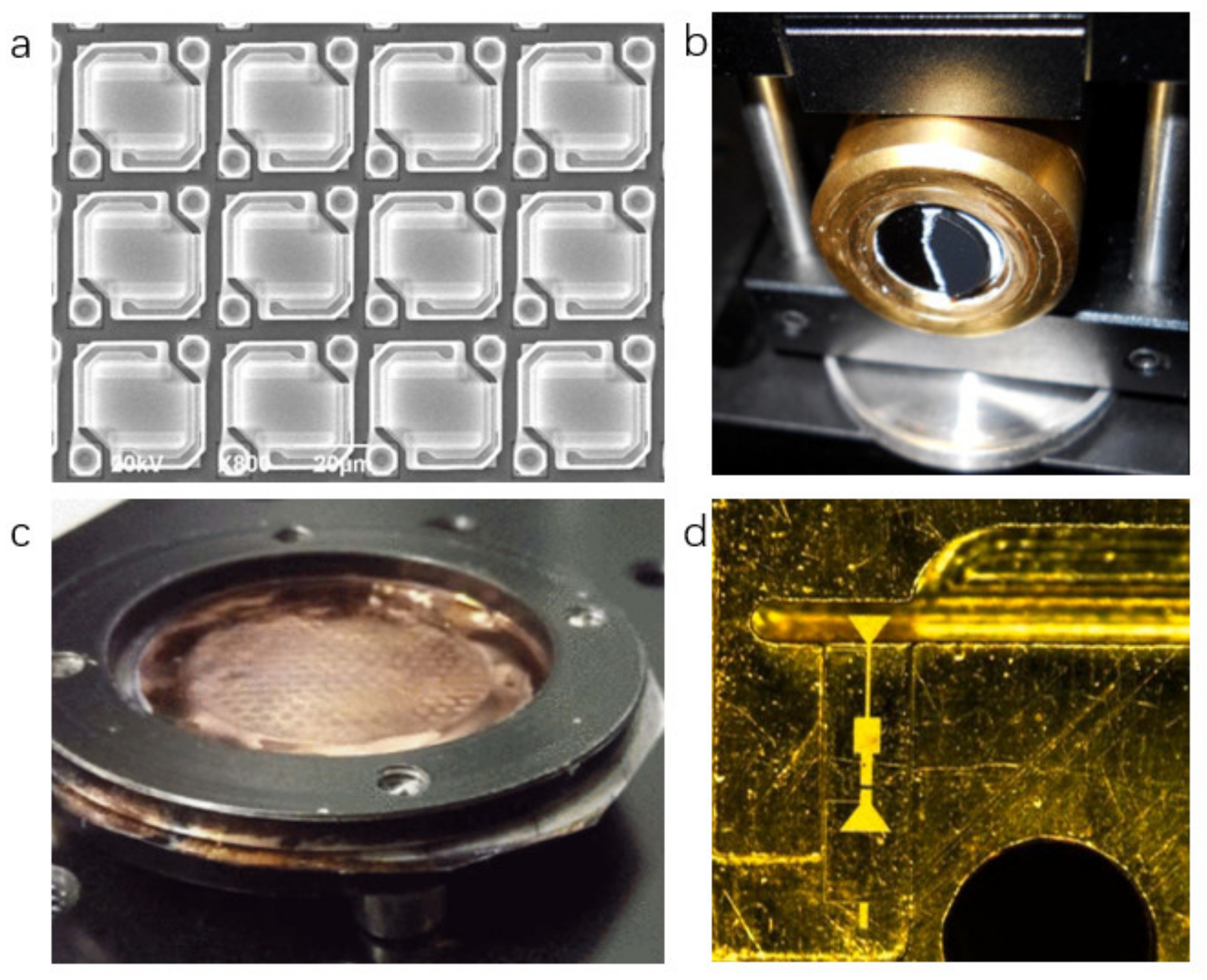
2. Classification of Graphene Terahertz Detectors
2.1. Non-Zero Bias Detectors
2.2. Zero-Bias Detectors
2.2.1. The Detector Based on Photovoltaic Effect or Photothermoelectric Effect
2.2.2. The Photodetector Based on Plasma Wave Resonance
3. Terahertz Detectors Made by Different Graphene Preparation Methods
3.1. Mechanical Exfoliation
3.2. Chemical Vapor Deposition
3.3. SiC Epitaxial Growth
4. Challenges and Future Perspective of Graphene Based Detectors
5. Discussion and Conclusions
Author Contributions
Funding
Conflicts of Interest
References
- Liu, S.G. The new development of terahertz science and technology. Basic Sci. China 2006, 8, 7–12. [Google Scholar] [CrossRef]
- Hu, B.B.; Nuss, M.C. Imaging with terahertz waves. Opt. Lett. 1995, 20, 1716. [Google Scholar] [CrossRef]
- Seeds, A.J.; Williams, K.J. Microwave Photonics. J. Lightwave Technol. 2007, 24, 4628–4641. [Google Scholar] [CrossRef]
- Tonouchi, M. Cutting-edge terahertz technology. Nat. Photonics 2007, 1, 97–105. [Google Scholar] [CrossRef]
- Siegel, P.H. Terahertz Technology. IEEE Trans. Microw. Theory Tech. 2002, 50, 910–928. [Google Scholar] [CrossRef]
- Cook, D.J.; Decker, B.K.; Maislin, G.; Allen, M.G.; Hwu, R.J. Through container THz sensing: Applications for explosives screening. Proc. SPIE 2004, 5354, 55–62. [Google Scholar]
- Federici, J.F.; Schulkin, B.; Huang, F.; Gary, D.; Barat, R.; Oliveira, F.; Zimdars, D. THz imaging and sensing for security applications—Explosives, weapons and drugs. Semicond. Sci. Technol. 2005, 20, S266. [Google Scholar] [CrossRef]
- Han, P.Y.; Chen, J.; Zhao, H.W.; Schulkin, B.; Chen, Y.Q.; Bastiaans, G.; Warrender, J.; Zhang, X.C. Application of Terahertz Spectroscopy in Security, Chemistry & Microscopy. Presented at the Laser Applications to Chemical, Security and Environmental Analysis, St. Petersburg, FL, USA, 17 March 2008. [Google Scholar]
- Woodward, R. Terahertz pulse imaging in reflection geometry of human skin cancer and skin tissue. Phys. Med. Biol. 2002, 47, 3853. [Google Scholar] [CrossRef] [PubMed]
- Yalcin, A.; Popat, K.C.; Aldridge, J.C.; Desai, T.A.; Hryniewicz, J.; Chbouki, N.; Little, B.E.; King, O.; Van, V.; Chu, S. Optical sensing of biomolecules using microring resonators. IEEE J. Sel. Top. Quantum Electron. 2016, 12, 148–155. [Google Scholar] [CrossRef]
- Rogalski, A.; Sizov, F. Terahertz detectors and focal plane arrays. Opto-Electron. Rev. 2011, 19, 346–404. [Google Scholar] [CrossRef]
- Hu, F.; Lucyszyn, S. Modelling Miniature Incandescent Light Bulbs for Thermal Infrared ‘THz Torch’ Applications. J. Infrared Millim. Terahertz Waves 2015, 36, 350–367. [Google Scholar] [CrossRef][Green Version]
- Seliverstov, S.; Maslennikov, S.; Ryabchun, S.; Finkel, M.; Klapwijk, T.M.; Kaurova, N.; Vachtomin, Y.; Smirnov, K.; Voronov, B.; Gol”Tsman, G. Fast and Sensitive Terahertz Direct Detector Based on Superconducting Antenna-Coupled Hot Electron Bolometer. IEEE Trans. Appl. Supercond. 2015, 25, 1–4. [Google Scholar] [CrossRef]
- Timofeev, A.; Luomahaara, J.; Gronberg, L.; Mayra, A.; Sipola, H.; Aikio, M.; Metso, M.; Vesterinen, V.; Tappura, K.; Ala-Laurinaho, J. Optical and Electrical Characterization of a Large Kinetic Inductance Bolometer Focal Plane Array. IEEE Trans. Terahertz Sci. Technol. 2017, PP, 1–7. [Google Scholar] [CrossRef]
- Wu, C.; Zhou, W.; Yao, N.; Xu, X.; Qu, Y.; Zhang, Z.; Wu, J.; Jiang, L.; Huang, Z.; Chu, J. Silicon-based high sensitivity of room-temperature microwave and sub-terahertz detector. Appl. Phys. Express 2019, 12, 052013. [Google Scholar] [CrossRef]
- Hu, F.; Sun, J.; Brindley, H.E.; Liang, X.; Lucyszyn, S. Systems Analysis for Thermal Infrared ‘THz Torch’ Applications. J. Infrared Millim. Terahertz Waves 2015, 36, 474–495. [Google Scholar] [CrossRef]
- Li, W.; Liang, Z.; Wang, J.; Gou, J.; Jiang, Y. A direct method of thermal time constant measurement for lithium tantalate based terahertz pryroelectric detectors. J. Mater. Sci. Mater. Electron. 2016, 27, 9996–10002. [Google Scholar] [CrossRef]
- Müller, R.; Gutschwager, B.; Hollandt, J.; Kehrt, M.; Monte, C.; Müller, R.; Steiger, A. Characterization of a Large-Area Pyroelectric Detector from 300GHz to 30THz. J. Infrared Millim. Terahertz Waves 2015, 36, 654–661. [Google Scholar] [CrossRef]
- Yamashita, K.; Murata, A.; Okuyama, M. Golay-cell type of miniaturized infrared sensor using Si-diaphragm. Presented at the International Solid State Sensors and Actuators Conference (Transducers ’97), Chicago, IL, USA, 19 June 1997. [Google Scholar]
- Schlecht, M.T.; Preu, S.; Malzer, S.; Weber, H.B. An efficient Terahertz rectifier on the graphene/SiC materials platform. Sci. Rep. 2019, 9, 11205. [Google Scholar] [CrossRef] [PubMed]
- Liang, S.; Sheng, H.; Liu, Y.; Huo, Z.; Lu, Y.; Shen, H. ZnO Schottky ultraviolet photodetectors. J. Cryst. Growth 2001, 225, 110–113. [Google Scholar] [CrossRef]
- Sakhno, M.; Golenkov, A.; Sizov, F. Uncooled detector challenges: Millimeter-wave and terahertz long channel field effect transistor and Schottky barrier diode detectors. J. Appl. Phys. 2013, 114, 164503. [Google Scholar] [CrossRef]
- Tauk, R.; Teppe, F.; Boubanga, S.; Coquillat, D.; Knap, W.; Meziani, Y.M.; Gallon, C.; Boeuf, F.; Skotnicki, T.; Fenouillet-Beranger, C.; et al. Plasma wave detection of terahertz radiation by silicon field effects transistors: Responsivity and noise equivalent power. Appl. Phys. Lett. 2006, 89, 253511. [Google Scholar] [CrossRef]
- Javadi, E.; But, D.B.; Ikamas, K.; Zdanevičius, J.; Knap, W.; Lisauskas, A. Sensitivity of Field-Effect Transistor-Based Terahertz Detectors. Sensors 2021, 21, 2909. [Google Scholar] [CrossRef]
- Suziedelis, A.; Gradauskas, J.; Asmontas, S.; Valusis, G.; Roskos, H.G. Giga- and terahertz frequency band detector based on an asymmetrically necked n-n+-GaAs planar structure. J. Appl. Phys. 2003, 93, 3034–3038. [Google Scholar] [CrossRef]
- Kasalynas, I.; Seliuta, D.; Simniskis, R.; Tamosiunas, V.; Koehler, K.; Valusis, G. Terahertz imaging with bow-tie InGaAs-based diode with broken symmetry. Electron. Lett. 2009, 45, 833–835. [Google Scholar] [CrossRef]
- Seliuta, D.; Kasalynas, I.; Tamosiunas, V.; Balakauskas, S.; Martunas, Z.; Asmontas, S.; Valusis, G.; Lisauskas, A.; Roskos, H.G.; Kohler, K. Silicon lens-coupled bow-tie InGaAs-based broadband terahertz sensor operating at room temperature. Electron. Lett. 2006, 42, 825–827. [Google Scholar] [CrossRef]
- Kosarev, A.; Rumyantsev, S.; Moreno, M.; Torres, A.; Boubanga, S.; Knap, W. SixGey:H-based micro-bolometers studied in the terahertz frequency range. Solid State Electron. 2010, 54, 417–419. [Google Scholar] [CrossRef]
- Ajakaiye, O.; Grade, J.; Shin, C.; Kenny, T. Wafer-scale fabrication of infrared detectors based on tunneling displacement transducers. Sens. Actuators A Phys. 2007, 134, 575–581. [Google Scholar] [CrossRef]
- Rogalski, A. Terahertz detectors and focal plane arrays. Elektronika 2010, 51, 93–108. [Google Scholar]
- Vitiello, M.S. Semiconductor nanowires for highly sensitive, room-temperature detection of terahertz quantum cascade laser emission. Appl. Phys. Lett. 2012, 100, 97. [Google Scholar] [CrossRef]
- Preu, S.; Mittendorff, M.; Winnerl, S.; Lu, H.; Gossard, A.C.; Weber, H.B. Ultra-fast transistor-based detectors for precise timing of near infrared and THz signals. Opt. Express 2013, 21, 17941–17950. [Google Scholar] [CrossRef]
- Liu, Z.; Liang, Z.; Tang, W.; Xu, X. Design and fabrication of low-deformation micro-bolometers for THz detectors. Infrared Phys. Technol. 2020, 105, 103241. [Google Scholar] [CrossRef]
- Theocharous, S.P.; Theocharous, E.; Lehman, J.H. The evaluation of the performance of two pyroelectric detectors with vertically aligned multi-walled carbon nanotube coatings. Infrared Phys. Technol. 2012, 55, 299–305. [Google Scholar] [CrossRef]
- Stefanova, P.S.; Hammler, J.M.; Klein, A.K.; Gallant, A.J.; Balocco, C. Polymer-based micro-golay cells for THz detection. Presented at the 2016 41st International Conference on Infrared, Millimeter, and Terahertz Waves (IRMMW-THz), Copenhagen, Denmark, 25–30 September 2016. [Google Scholar]
- Daghestani, N.; Parow-Souchon, K.; Pardo, D.; Liu, H.; Brewster, N.; Frogley, M.; Cinque, G.; Alderman, B.; Huggard, P.G. Room temperature ultrafast InGaAs Schottky diode based detectors for terahertz spectroscopy. Infrared Phys. Technol. 2019, 99, 240–247. [Google Scholar] [CrossRef]
- Chen, H.; Padilla, W.; Zide, J.; Gossard, A.; Taylor, A.; Averitt, R. Active terahertz metamaterial devices. Nature 2006, 444, 597–600. [Google Scholar] [CrossRef]
- Guo, W.; Dong, Z.; Xu, Y.; Liu, C.; Wei, D.; Zhang, L.; Shi, X.; Guo, C.; Xu, H.; Chen, G.; et al. Sensitive Terahertz Detection and Imaging Driven by the Photothermoelectric Effect in Ultrashort-Channel Black Phosphorus Devices. Adv. Sci. 2020, 7, 1902699. [Google Scholar] [CrossRef]
- Zhang, Y.; Li, H.; Wang, L.; Wang, H.; Xie, X.; Zhang, S.-L.; Liu, R.; Qiu, Z.-J. Photothermoelectric and photovoltaic effects both present in MoS2. Sci. Rep. 2015, 5, 7938. [Google Scholar] [CrossRef]
- Novoselov, K.S.; Geim, A.K.; Morozov, S.V.; Jiang, D.; Zhang, Y.; Dubonos, S.V.; Grigorieva, I.V.; Firsov, A.A. Electric Field Effect in Atomically Thin Carbon Films. Science 2004, 306, 666–669. [Google Scholar] [CrossRef] [PubMed]
- Allen, M.J.; Tung, V.C.; Kaner, R.B. Honeycomb Carbon: A Review of Graphene. Chem. Rev. 2010, 110, 132–145. [Google Scholar] [CrossRef]
- Geim, A.K.; Novoselov, K.S. The rise of graphene. Nat. Mater. 2009, 6, 11–19. [Google Scholar]
- Castro Neto, A.H.; Guinea, F.; Peres, N.M.R.; Novoselov, K.S.; Geim, A.K. The electronic properties of graphene. Rev. Mod. Phys. 2009, 81, 109–162. [Google Scholar] [CrossRef]
- Bolotin, K.I.; Sikes, K.J.; Jiang, Z.; Klima, M.; Fudenberg, G.; Hone, J.; Kim, P.; Stormer, H.L. Ultrahigh electron mobility in suspended graphene. Solid State Commun. 2008, 146, 351–355. [Google Scholar] [CrossRef]
- Balandin, A.A. Thermal properties of graphene and nanostructured carbon materials. Nat. Mater. 2011, 10, 569–581. [Google Scholar] [CrossRef] [PubMed]
- Pei, Z.; Chauhan, J.; Jing, G. Computational Study of Tunneling Transistor Based on Graphene Nanoribbon. Nano Lett. 2009, 9, 684–688. [Google Scholar]
- Eda, G.; Chhowalla, M. Graphene-based composite thin films for electronics. Nano Lett. 2009, 9, 814–818. [Google Scholar] [CrossRef] [PubMed]
- Zhang, Y.; Du, J.; Tang, S.; Liu, P.; Deng, S.; Chen, J.; Xu, N. Optimize the field emission character of a vertical few-layer graphene sheet by manipulating the morphology. Nanotechnology 2011, 23, 015202. [Google Scholar] [CrossRef]
- Kawano, Y. Wide-band frequency-tunable terahertz and infrared detection with graphene. Nanotechnology 2013, 24, 214004. [Google Scholar] [CrossRef]
- Müller, R.; Bohmeyer, W.; Kehrt, M.; Lange, K.; Monte, C.; Steiger, A. Novel detectors for traceable THz power measurements. J. Infrared Millim. Terahertz Waves 2014, 35, 659–670. [Google Scholar] [CrossRef]
- Dawlaty, J.M.; Shivaraman, S.; Strait, J.; George, P.; Chandrashekhar, M.; Rana, F.; Spencer, M.G.; Veksler, D.; Chen, Y. Measurement of the Optical Absorption Spectra of Epitaxial Graphene from Terahertz to Visible. Appl. Phys. Lett. 2008, 93, 131905. [Google Scholar] [CrossRef]
- Pinto, S.; Krishna, R.; Dias, C.; Pimentel, G.; Oliveira, G.N.P.; Teixeira, J.M.; Aguiar, P.; Titus, E.; Gracio, J.; Ventura, J. Resistive switching and activity-dependent modifications in Ni-doped graphene oxide thin films. Appl. Phys. Lett. 2012, 101, 2632. [Google Scholar] [CrossRef]
- Wang, F.; Zhang, Y.; Tian, C.; Girit, C.; Zettl, A.; Crommie, M.; Shen, Y.R. Gate-variable optical transitions in graphene. Science 2008, 320, 206–209. [Google Scholar] [CrossRef]
- Neto, A.; Guinea, F.; Peres, N.; Novoselov, K.S.; Geim, A. The electronic properties of graphene and its bilayer. Vacuum 2009, 83, 1248–1252. [Google Scholar]
- Makaram, P.; Joh, J.; Alamo, J.A.D.; Palacios, T.; Thompson, C.V. Evolution of structural defects associated with electrical degradation in AlGaN/GaN high electron mobility transistors. Appl. Phys. Lett. 2010, 96, 756–758. [Google Scholar] [CrossRef]
- Mckitterick, C.B.; Prober, D.E.; Karasik, B.S. Performance of Graphene Thermal Photon Detectors. J. Appl. Phys. 2013, 113, 379. [Google Scholar] [CrossRef]
- Yan, J.; Kim, M.H.; Elle, J.A.; Sushkov, A.B.; Jenkins, G.S.; Milchberg, H.M.; Fuhrer, M.S.; Drew, H.D. Dual-gated bilayer graphene hot-electron bolometer. Nat. Nanotechnol. 2012, 7, 472–478. [Google Scholar] [CrossRef]
- Lee, G.-H.; Efetov, D.K.; Jung, W.; Ranzani, L.; Walsh, E.D.; Ohki, T.A.; Taniguchi, T.; Watanabe, K.; Kim, P.; Englund, D.; et al. Graphene-based Josephson junction microwave bolometer. Nature 2020, 586, 42–46. [Google Scholar] [CrossRef]
- Ryzhii, V.; Otsuji, T.; Ryzhii, M.; Ryabova, N.; Yurchenko, S.O.; Mitin, V.; Shur, M.S. Graphene terahertz uncooled bolometers. J. Phys. D Appl. Phys. 2012, 46, 065102. [Google Scholar] [CrossRef]
- Dicke, R.H. The Measurement of Thermal Radiation at Microwave Frequencies; Springer: Dordrecht, The Netherlands, 1982. [Google Scholar]
- Li, J.; Zhao, Y.; Tang, L.; Nie, C.; Yao, W. A Polarization-Sensitive Multiband Plasmonic Hot Electron Photodetector Based on Conformal MoS. J. Nanosci. Nanotechnol. 2019, 19, 213–219. [Google Scholar] [CrossRef] [PubMed]
- Wu, K.; Zhan, Y.; Zhang, C.; Wu, S.; Li, X. Strong and highly asymmetrical optical absorption in conformal metal-semiconductor-metal grating system for plasmonic hot-electron photodetection application. Sci. Rep. 2015, 5, 14304. [Google Scholar] [CrossRef]
- Mckitterick, C.B.; Vora, H.; Du, X.; Karasik, B.S.; Prober, D.E. Graphene Microbolometers with Superconducting Contacts for Terahertz Photon Detection. J. Low Temp. Phys. 2014, 176, 291–298. [Google Scholar] [CrossRef]
- Betz, A.C.; Vialla, F.; Brunel, D.; Voisin, C.; Picher, M.; Cavanna, A.; Madouri, A.; Fève, G.; Berroir, J.M.; Plaçais, B.; et al. Hot Electron Cooling by Acoustic Phonons in Graphene. Phys. Rev. Lett. 2012, 109, 056805. [Google Scholar] [CrossRef]
- Fong, K.C.; Schwab, K.C. Ultrasensitive and Wide-Bandwidth Thermal Measurements of Graphene at Low Temperatures. Phys. Rev. X 2012, 2, 031006. [Google Scholar] [CrossRef]
- Miao, W.; Gao, H.; Wang, Z.; Zhang, W.; Ren, Y.; Zhou, K.M.; Shi, S.C.; Yu, C.; He, Z.Z.; Liu, Q.B. A Graphene-Based Terahertz Hot Electron Bolometer with Johnson Noise Readout. J. Low Temp. Phys. 2018, 193, 387–392. [Google Scholar] [CrossRef]
- Gayduchenko, I.; Xu, S.G.; Alymov, G.; Moskotin, M.; Tretyakov, I.; Taniguchi, T.; Watanabe, K.; Goltsman, G.; Geim, A.K.; Fedorov, G.; et al. Tunnel field-effect transistors for sensitive terahertz detection. Nat. Commun. 2021, 12, 543. [Google Scholar] [CrossRef]
- Tomadin, A.; Tredicucci, A.; Pellegrini, V.; Vitiello, M.S.; Polini, M. Photocurrent-Based detection of Terahertz radiation in graphene. Appl. Phys. Lett. 2013, 103, 211120. [Google Scholar] [CrossRef]
- Kawano, Y.; Ishibashi, K. Wide-band frequency-selective terahertz detection based on a single-layer graphene. Presented at the 2009 34th International Conference on Infrared, Millimeter, and Terahertz Waves, Busan, Korea, 21–25 September 2009. [Google Scholar]
- Tan, R.B.; Qin, H.; Sun, J.D.; Zhang, X.Y.; Zhang, B.S. Modeling an antenna-coupled graphene field-effect terahertz detector. Appl. Phys. Lett. 2013, 103, 143. [Google Scholar] [CrossRef]
- Song, J.C.W.; Rudner, M.S.; Marcus, C.M.; Levitov, L.S. Hot Carrier Transport and Photocurrent Response in Graphene. Nano Lett. 2011, 11, 4688–4692. [Google Scholar] [CrossRef]
- Castilla, S.; Terrés, B.; Autore, M.; Viti, L.; Li, J.; Nikitin, A.Y.; Vangelidis, I.; Watanabe, K.; Taniguchi, T.; Lidorikis, E.; et al. Fast and Sensitive Terahertz Detection Using an Antenna-Integrated Graphene pn Junction. Nano Lett. 2019, 19, 2765–2773. [Google Scholar] [CrossRef]
- Degl’Innocenti, R.; Xiao, L.; Jessop, D.S.; Kindness, S.J.; Ren, Y.; Lin, H.; Zeitler, J.A.; Alexander-Webber, J.A.; Joyce, H.J.; Braeuninger-Weimer, P. Fast Room-Temperature Detection of Terahertz Quantum Cascade Lasers with Graphene-Loaded Bow-Tie Plasmonic Antenna Arrays. ACS Photonics 2016, 3, 1747–1753. [Google Scholar] [CrossRef]
- Cai, X.; Sushkov, A.B.; Suess, R.J.; Jadidi, M.M.; Jenkins, G.S.; Nyakiti, L.O.; Myers-Ward, R.L.; Li, S.; Yan, J.; Gaskill, D.K.; et al. Sensitive room-temperature terahertz detection via the photothermoelectric effect in graphene. Nat. Nanotechnol. 2014, 9, 814–819. [Google Scholar] [CrossRef]
- Wanlong, G.; Lin, W.; Xiaoshuang, C.; Changlong, L.; Weiwei, T.; Cheng, G.; Jin, W.; Wei, L. Graphene-based broadband terahertz detector integrated with a square-spiral antenna. Opt. Lett. 2018, 43, 1647–1650. [Google Scholar]
- Xu, Y.Y.; Xu, Y.; Hu, J.; Yin, W.Y. Design of a novel reconfigurable Sierpinski fractal graphene antenna operating at THz band. Presented at the 2013 IEEE International Symposium on Antennas and Propagation & USNC/URSI National Radio Science Meeting, Orlando, FL, USA, 7–13 July 2013. [Google Scholar]
- Hong, S.K.; Jeon, S.C.; Hwang, W.S.; Cho, B.J. Resistance analysis and device design guideline for graphene RF transistors. 2D Materials 2015, 2, 034011. [Google Scholar] [CrossRef]
- Huang, Z.; Han, Q.; Ji, C.; Wang, J.; Jiang, Y. Broadband terahertz modulator based on graphene metamaterials. AIP Adv. 2018, 8, 035304. [Google Scholar] [CrossRef]
- Borzooei, S.; Rezagholizadeh, E.; Biabanifard, M. Graphene disks for frequency control of terahertz waves in broadband applications. J. Comput. Electron. 2020, 19, 1–4. [Google Scholar] [CrossRef]
- Yi, Z.; Chen, J.; Cen, C.; Chen, X.; Zhou, Z.; Tang, Y.; Ye, X.; Xiao, S.; Luo, W.; Wu, P. Tunable Graphene-based Plasmonic Perfect Metamaterial Absorber in the THz Region. Micromachines 2019, 10, 194. [Google Scholar] [CrossRef] [PubMed]
- Amirmazlaghani, M.; Raissi, F. Feasibility of Room-Temperature GHz-THz Direct Detection in Graphene Through Hot-Carrier Effect. IEEE Trans. Device Mater. Reliab. 2018, 18, 429–437. [Google Scholar] [CrossRef]
- Li, Y.; Zhang, Y.; Yu, Y.; Chen, Z.; Yao, J.Q. Ultraviolet-to-Microwave Room Temperature Photodetectors Based on Three-dimensional Graphene Foams. Photonics Res. 2020, 8, 368–374. [Google Scholar] [CrossRef]
- Chen, M.; Wang, Y.; Wen, J.; Chen, H.; Ma, W.; Fan, F.; Huang, Y.; Zhao, Z. Annealing Temperature-Dependent Terahertz Thermal–Electrical Conversion Characteristics of Three-Dimensional Microporous Graphene. ACS Appl. Mater. Interfaces 2019, 11, 6411–6420. [Google Scholar] [CrossRef] [PubMed]
- Dyakonov, M.; Shur, M. Shallow water analogy for a ballistic field effect transistor: New mechanism of plasma wave generation by dc current. Phys. Rev. Lett. 1993, 71, 2465–2468. [Google Scholar] [CrossRef] [PubMed]
- Knap, W.; Dyakonov, M.; Coquillat, D.; Teppe, F.; Dyakonova, N.; Łusakowski, J.; Karpierz, K.; Sakowicz, M.; Valusis, G.; Seliuta, D.; et al. Field Effect Transistors for Terahertz Detection: Physics and First Imaging Applications. J. Infrared Millim. Terahertz Waves 2009, 30, 1319–1337. [Google Scholar] [CrossRef]
- Teppe, F.; Orlov, M.; El Fatimy, A.; Tiberj, A.; Knap, W.; Torres, J.; Gavrilenko, V.; Shchepetov, A.; Roelens, Y.; Bollaert, S. Room temperature tunable detection of subterahertz radiation by plasma waves in nanometer InGaAs transistors. Appl. Phys. Lett. 2006, 89, 222109. [Google Scholar] [CrossRef]
- Meziani, Y.M.; Hanabe, M.; Koizumi, A.; Otsuji, T.; Sano, E. Self Oscillation of the Plasma Waves in a Dual Grating Gates HEMT Device. Presented at the IEEE International Conference on Indium Phosphide & Related Materials, Matsue, Japan, 14–18 May 2007. [Google Scholar]
- Soltani, A.; Kuschewski, F.; Bonmann, M.; Generalov, A.; Roskos, H.G. Direct nanoscopic observation of plasma waves in the channel of a graphene field-effect transistor. Light Sci. Appl. 2020, 9, 97. [Google Scholar] [CrossRef] [PubMed]
- Sun, J. Field-Effect Self-Mixing Mechanism and Detector Model. In Field-Effect Self-Mixing Terahertz Detectors; Sun, J., Ed.; Springer: Berlin/Heidelberg, Germany, 2016; pp. 19–39. [Google Scholar] [CrossRef]
- Jadidi, M.M.; Sushkov, A.; Myers-Ward, R.L.; Boyd, A.; Daniels, K.; Gaskill, D.K.; Fuhrer, M.S.; Drew, H.D.; Murphy, T.E. Tunable Terahertz Hybrid Metal–Graphene Plasmons. Nano Lett. 2015, 15, 7099–7104. [Google Scholar] [CrossRef]
- Rana, F. Graphene Terahertz Plasmon Oscillators. IEEE Trans. Nanotechnol. 2008, 7, 91–99. [Google Scholar] [CrossRef]
- Wang, L.; Chen, X.; Yu, A.; Zhang, Y.; Ding, J.; Lu, W. Highly Sensitive and Wide-Band Tunable Terahertz Response of Plasma Waves Based on Graphene Field Effect Transistors. Sci. Rep. 2014, 4, 5470. [Google Scholar] [CrossRef]
- Novoselov, K.S.; Geim, A.K.; Morozov, S.V.; Jiang, D.; Katsnelson, M.I.; Grigorieva, I.V.; Dubonos, S.V.; Firsov, A.A. Two-dimensional gas of massless Dirac fermions in graphene. Nature 2005, 438, 197–200. [Google Scholar] [CrossRef]
- Echtermeyer, T.J.; Lemme, M.C.; Bolten, J.; Baus, M.; Ramsteiner, M.; Kurz, H. A Graphene Field-Effect Device. Eur. Phys. J. Spec. Top. 2007, 148, 19–26. [Google Scholar] [CrossRef]
- Ryzhii, V.; Ryzhii, M. Graphene bilayer field-effect phototransistor for terahertz and infrared detection. Phys. Rev. B 2009, 79, 245311. [Google Scholar] [CrossRef]
- Lin, Y.M.; Dimitrakopoulos, C.; Jenkins, K.A.; Farmer, D.B.; Chiu, H.Y.; Grill, A.; Avouris, P. 100-GHz transistors from wafer-scale epitaxial graphene. Science 2010, 327, 662. [Google Scholar] [CrossRef]
- Lin, Y.M.; Valdes-Garcia, A.; Han, S.J.; Farmer, D.B.; Meric, I.; Sun, V.; Wu, Y.; Dimitrakopoulos, C.; Grill, A.; Avouris, P. Wafer-Scale Graphene Integrated Circuit. Science 2011, 332, 1294–1297. [Google Scholar] [CrossRef] [PubMed]
- Zhang, W.; Phi, H.Q.P.; Brown, E.R.; Burke, P.J. AC conductivity parameters of graphene derived from THz etalon transmittance. Nanoscale 2014, 6, 13895–13899. [Google Scholar] [CrossRef]
- Sizov, F.; Rogalski, A. THz detectors. Prog. Quantum Electron. 2010, 34, 278–347. [Google Scholar] [CrossRef]
- Tong, J.; Muthee, M.; Chen, S.Y.; Yngvesson, S.K.; Yan, J. Antenna enhanced graphene THz emitter and detector. Nano Lett. 2015, 15, 5295. [Google Scholar] [CrossRef]
- Qin, H.; Sun, J.; He, Z.; Li, X.; Li, X.; Liang, S.; Yu, C.; Feng, Z.; Tu, X.; Jin, B.; et al. Heterodyne detection at 216, 432, and 648 GHz based on bilayer graphene field-effect transistor with quasi-optical coupling. Carbon 2017, 121, 235–241. [Google Scholar] [CrossRef]
- Mittendorff, M.; Winnerl, S.; Kamann, J.; Eroms, J.; Weiss, D.; Schneider, H.; Helm, M. Ultrafast graphene-based broadband THz detector. Appl. Phys. Lett. 2013, 103, 666. [Google Scholar] [CrossRef]
- Liu, C.; Du, L.; Tang, W.; Wei, D.; Li, J.; Wang, L.; Chen, G.; Chen, X.; Lu, W. Towards sensitive terahertz detection via thermoelectric manipulation using graphene transistors. NPG Asia Mater. 2018, 10, 318–327. [Google Scholar] [CrossRef]
- Viti, L.; Purdie, D.G.; Lombardo, A.; Ferrari, A.C.; Vitiello, M.S. HBN-encapsulated, graphene-based room-temperature terahertz receivers with high speed and low noise. Nano Lett. 2020, 20, 3169–3177. [Google Scholar] [CrossRef] [PubMed]
- Novotny, L.; Van Hulst, N. Antennas for light. Nat. Photonics 2011, 5, 83–90. [Google Scholar] [CrossRef]
- Sensale-Rodriguez, B. Graphene-insulator-graphene active plasmonic terahertz devices. Appl. Phys. Lett. 2013, 103, 123109. [Google Scholar] [CrossRef]
- Fatimy, A.E.; Myers-Ward, R.L.; Boyd, A.K.; Daniels, K.M.; Gaskill, D.K.; Barbara, P. Epitaxial graphene quantum dots for high-performance THz bolometers. arXiv 2015, arXiv:1509.04646. [Google Scholar]
- Cai, X.; Sushkov, A.B.; Jadidi, M.M.; Nyakiti, L.O.; Myers-Ward, R.L.; Gaskill, D.K.; Murphy, T.E.; Fuhrer, M.S.; Drew, H.D. Plasmon-Enhanced Terahertz Photodetection in Graphene. Nano Lett. 2015, 15, 4295–4302. [Google Scholar] [CrossRef] [PubMed]
- Mikhailov, S.A.; Savostianova, N.A. Influence of contacts on the microwave response of a two-dimensional electron stripe. Phys. Rev. B Condens. Matter Mater. Phys. 2006, 74, 045325. [Google Scholar] [CrossRef]
- Drexler, C.; Dyakonova, N.; Olbrich, P.; Karch, J.; Schafberger, M.; Karpierz, K.; Mityagin, Y.; Lifshits, M.B.; Teppe, F.; Klimenko, O. Helicity sensitive terahertz radiation detection by field effect transistors. J. Appl. Phys. 2012, 111, 380–2833. [Google Scholar] [CrossRef]
- Matyushkin, Y.; Danilov, S.; Moskotin, M.; Belosevich, V.; Kaurova, N.; Rybin, M.; Obraztsova, E.D.; Fedorov, G.; Gorbenko, I.; Kachorovskii, V.; et al. Helicity-Sensitive Plasmonic Terahertz Interferometer. Nano Lett. 2020, 20, 7296–7303. [Google Scholar] [CrossRef]
- Auton, G.; But, D.B.; Zhang, J.; Hill, E.; Coquillat, D.; Consejo, C.; Nouvel, P.; Knap, W.; Varani, L.; Teppe, F.; et al. Terahertz Detection and Imaging Using Graphene Ballistic Rectifiers. Nano Lett. 2017, 17, 7015–7020. [Google Scholar] [CrossRef]
- Hackley, J.; Ali, D.; Dipasquale, J.; Demaree, J.D.; Richardson, C.J.K. Graphitic carbon growth on Si(111) using solid source molecular beam epitaxy. Appl. Phys. Lett. 2009, 95, 133114. [Google Scholar] [CrossRef]
- Hernandez, Y.; Nicolosi, V.; Lotya, M.; Blighe, F.M.; Sun, Z.; De, S.; McGovern, I.T.; Holland, B.; Byrne, M.; Gun’Ko, Y.K.; et al. High-yield production of graphene by liquid-phase exfoliation of graphite. Nat. Nanotechnol. 2008, 3, 563–568. [Google Scholar] [CrossRef]
- Blake, P.; Brimicombe, P.D.; Nair, R.R.; Booth, T.J.; Jiang, D.; Schedin, F.; Ponomarenko, L.A.; Morozov, S.V.; Gleeson, H.F.; Hill, E.W.; et al. Graphene-Based Liquid Crystal Device. Nano Lett. 2008, 8, 1704–1708. [Google Scholar] [CrossRef] [PubMed]
- Casiraghi, C.; Pisana, S.; Novoselov, K.S.; Geim, A.K.; Ferrari, A.C. Raman fingerprint of charged impurities in graphene. Appl. Phys. Lett. 2007, 91, 183. [Google Scholar] [CrossRef]
- Novoselov, K.S.; Fal’Ko, V.I.; Colombo, L.; Gellert, P.R.; Kim, K.A. A Roadmap for graphene. Nature 2012, 490, 192–200. [Google Scholar] [CrossRef]
- Novoselov, K.S.; Jiang, D.; Schedin, F.; Booth, T.J.; Khotkevich, V.V.; Morozov, S.V.; Geim, A.K. Two-dimensional atomic crystals. Proc. Natl. Acad. Sci. USA 2005, 102, 10451–10453. [Google Scholar] [CrossRef]
- Liang, X.; Fu, Z.; Chou, S.Y. Graphene Transistors Fabricated via Transfer-Printing In Device Active-Areas on Large Wafer. Nano Lett. 2007, 7, 3840–3844. [Google Scholar] [CrossRef]
- Zhang, Y.; Small, J.P.; Pontius, W.V.; Kim, P. Fabrication and electric-field-dependent transport measurements of mesoscopic graphite devices. Appl. Phys. Lett. 2005, 86, 073104. [Google Scholar] [CrossRef]
- Xuan, Y.; Wu, Y.Q.; Shen, T.; Qi, M.; Capano, M.A.; Cooper, J.A.; Ye, P.D. Atomic-layer-deposited nanostructures for graphene-based nanoelectronics. Appl. Phys. Lett. 2008, 92, 013101. [Google Scholar] [CrossRef]
- Vicarelli, L.; Vitiello, M.S.; Coquillat, D.; Lombardo, A.; Ferrari, A.C.; Knap, W.; Polini, M.; Pellegrini, V.; Tredicucci, A. Graphene field-effect transistors as room-temperature terahertz detectors. Nat. Mater. 2012, 11, 865–871. [Google Scholar] [CrossRef]
- Vitiello, M.S.; Coquillat, D.; Viti, L.; Ercolani, D.; Teppe, F.; Pitanti, A.; Beltram, F.; Sorba, L.; Knap, W.; Tredicucci, A. Room-temperature terahertz detectors based on semiconductor nanowire field-effect transistors. Nano Lett 2012, 12, 96–101. [Google Scholar] [CrossRef] [PubMed]
- Liao, L.; Lin, Y.C.; Bao, M.; Cheng, R.; Bai, J.; Liu, Y.; Qu, Y.; Wang, K.L.; Huang, Y.; Duan, X. High-speed graphene transistors with a self-aligned nanowire gate. Nature 2010, 467, 305–308. [Google Scholar] [CrossRef]
- Kretinin, A.V.; Cao, Y.; Tu, J.S.; Yu, G.L.; Jalil, R.; Novoselov, K.S.; Haigh, S.J.; Gholinia, A.; Mishchenko, A.; Lozada, M.; et al. Electronic Properties of Graphene Encapsulated with Different Two-Dimensional Atomic Crystals. Nano Lett. 2014, 14, 3270–3276. [Google Scholar] [CrossRef]
- Bandurin, D.A.; Svintsov, D.; Gayduchenko, I.; Xu, S.G.; Principi, A.; Moskotin, M.; Tretyakov, I.; Yagodkin, D.; Zhukov, S.; Taniguchi, T.; et al. Resonant terahertz detection using graphene plasmons. Nat. Commun. 2018, 9, 5392. [Google Scholar] [CrossRef]
- Yu, Q.; Lian, J.; Siriponglert, S.; Li, H.; Chen, Y.P.; Pei, S.S. Graphene segregated on Ni surfaces and transferred to insulators. Appl. Phys. Lett. 2008, 93, 183. [Google Scholar] [CrossRef]
- Li, X.; Cai, W.; An, J.; Kim, S.; Nah, J.; Yang, D.; Piner, R.; Velamakanni, A.; Jung, I.; Tutuc, E.; et al. Large-area synthesis of high-quality and uniform graphene films on copper foils. Science 2009, 324, 1312–1314. [Google Scholar] [CrossRef] [PubMed]
- Pandey, S.; Rai, P.; Patole, S.; Gunes, F.; Kwon, G.D.; Yoo, J.B.; Nikolaev, P.; Arepalli, S. Improved electron field emission from morphologically disordered monolayer graphene. Appl. Phys. Lett. 2012, 100, 1179. [Google Scholar] [CrossRef]
- Malesevic, A.; Kemps, R.; Vanhulsel, A.; Chowdhury, M.P.; Volodin, A.; Haesendonck, C.V. Field emission from vertically aligned few-layer graphene. J. Appl. Phys. 2008, 104, 666. [Google Scholar] [CrossRef]
- Behura, S.K.; Mukhopadhyay, I.; Hirose, A.; Yang, Q.; Jani, O. Vertically oriented few-layer graphene as an electron field-emitter. Phys. Status Solidi (a) 2013, 210, 1817–1821. [Google Scholar] [CrossRef]
- Shakil, A.; Amiri, A.; Tang, H.; Polycarpou, A.A. High temperature nanomechanical and nanotribological behavior of sub-5 nm nitrogen-doped carbon overcoat films. Appl. Surf. Sci. 2020, 535, 147662. [Google Scholar] [CrossRef]
- Schmitz, M.; Engels, S.; Banszerus, L.; Watanabe, K.; Taniguchi, T.; Stampfer, C.; Beschoten, B. High mobility dry-transferred CVD bilayer graphene. Appl. Phys. Lett. 2017, 110, 263110. [Google Scholar] [CrossRef]
- Zak, A.; Andersson, M.A.; Bauer, M.; Matukas, J.; Lisauskas, A.; Roskos, H.G.; Stake, J. Antenna-integrated 0.6 THz FET direct detectors based on CVD graphene. Nano Lett. 2014, 14, 5834–5838. [Google Scholar] [CrossRef]
- Generalov, A.A.; Andersson, M.A.; Yang, X.; Vorobiev, A.; Stake, J. A 400-GHz Graphene FET Detector. IEEE Trans. Terahertz Sci. Technol. 2017, 7, 614–616. [Google Scholar] [CrossRef]
- Wu, X.; Hu, Y.; Ruan, M.; Madiomanana, N.K.; Hankinson, J.; Sprinkle, M.; Berger, C.; De Heer, W.A. Half integer quantum Hall effect in high mobility single layer epitaxial graphene. Appl. Phys. Lett. 2009, 95, 19912. [Google Scholar] [CrossRef]
- Forbeaux, I.; Themlin, J.-M.; Debever, J.-M. Heteroepitaxial graphite on 6H-SiC(0001): Interface formation through conduction-band electronic structure. Phys. Rev. B 1998, 58, 16396. [Google Scholar] [CrossRef]
- Ciuk, T.; Caban, P.; Strupinski, W. Charge carrier concentration and offset voltage in quasi-free-standing monolayer chemical vapor deposition graphene on SiC. Carbon 2016, 101, 431–438. [Google Scholar] [CrossRef]
- Bianco, F.; Perenzoni, D.; Convertino, D.; Bonis, S.L.D.; Spirito, D.; Perenzoni, M.; Coletti, C.; Vitiello, M.S.; Tredicucci, A. Terahertz detection by epitaxial-graphene field-effect-transistors on silicon carbide. Appl. Phys. Lett. 2015, 107, 131104. [Google Scholar] [CrossRef]
- Qin, H.; Sun, J.; Liang, S.; Li, X.; Yang, X.; He, Z.; Yu, C.; Feng, Z. Room-temperature, low-impedance and high-sensitivity terahertz direct detector based on bilayer graphene field-effect transistor. Carbon 2017, 116, 760–765. [Google Scholar] [CrossRef]
- GK, R.M.; Deshmukh, P.; Prabhu, S.S.; Basu, P.K. Antenna coupled graphene-FET as ultra-sensitive room temperature broadband THz detector. AIP Adv. 2018, 8, 125122. [Google Scholar] [CrossRef]
- Güttinger, J.; Molitor, F.; Stampfer, C.; Schnez, S.; Ensslin, K. Transport through graphene quantum dots. Rep. Prog. Phys. 2012, 75, 126502. [Google Scholar] [CrossRef] [PubMed]
- Fatimy, A.E.; Nath, A.; Kong, B.D.; Boyd, A.K.; Barbara, P. Ultra-broadband photodetectors based on epitaxial graphene quantum dots. Nanophotonics 2017, 7, 735–740. [Google Scholar] [CrossRef]
- Zhang, J.; Lin, L.; Jia, K.; Sun, L.; Peng, H.; Liu, Z. Controlled Growth of Single-Crystal Graphene Films. Adv. Mater. 2020, 32, 1903266. [Google Scholar] [CrossRef] [PubMed]
- Yang, X.; Zhang, G.; Prakash, J.; Chen, Z.; Sun, S. Chemical vapour deposition of graphene: Layer control, the transfer process, characterisation, and related applications. Int. Rev. Phys. Chem. 2019, 38, 149–199. [Google Scholar] [CrossRef]
- Kumar, S.; Mcevoy, N.; Kim, H.Y.; Lee, K.; Duesberg, G.S. CVD growth and processing of graphene for electronic applications. Phys. Status Solidi (b) 2011, 248, 2604–2608. [Google Scholar] [CrossRef]
- Reddy, D.; Register, L.F.; Carpenter, G.D.; Banerjee, S.K. Graphene field-effect transistors. J. Phys. D Appl. Phys. 2011, 44, 313001. [Google Scholar] [CrossRef]
- Donchev, E.; Pang, J.S.; Gammon, P.M.; Centeno, A.; Xie, F.; Petrov, P.K.; Breeze, J.D.; Ryan, M.P.; Riley, D.J.; McN, N. The rectenna device: From theory to practice (a review). MRS Energy Sustain. 2014, 1, 1. [Google Scholar] [CrossRef]
- Zhong, H.; Zhang, Z.; Chen, B.; Xu, H.; Yu, D.; Huang, L.; Peng, L. Realization of low contact resistance close to theoretical limit in graphene transistors. Nano Res. 2015, 8, 1669–1679. [Google Scholar] [CrossRef]
- Ponomarenko, L.A.; Yang, R.; Mohiuddin, T.M.; Katsnelson, M.I.; Novoselov, K.S.; Morozov, S.V.; Zhukov, A.A.; Schedin, F.; Hill, E.W.; Geim, A.K. Effect of a High-$\ensuremath{\kappa}$ Environment on Charge Carrier Mobility in Graphene. Phys. Rev. Lett. 2009, 102, 206603. [Google Scholar] [CrossRef]
- Lei, L.; Bai, J.; Qu, Y.; Yu, H.; Duan, X. Single-layer graphene on Al2O3/Si substrate: Better contrast and higher performance of graphene transistors. Nanotechnology 2010, 21, 015705. [Google Scholar]
- Regan, W.; Alem, N.; Alemán, B.; Geng, B.; Girit, Ç.; Maserati, L.; Wang, F.; Crommie, M.; Zettl, A. A direct transfer of layer-area graphene. Appl. Phys. Lett. 2010, 96, 113102. [Google Scholar] [CrossRef]

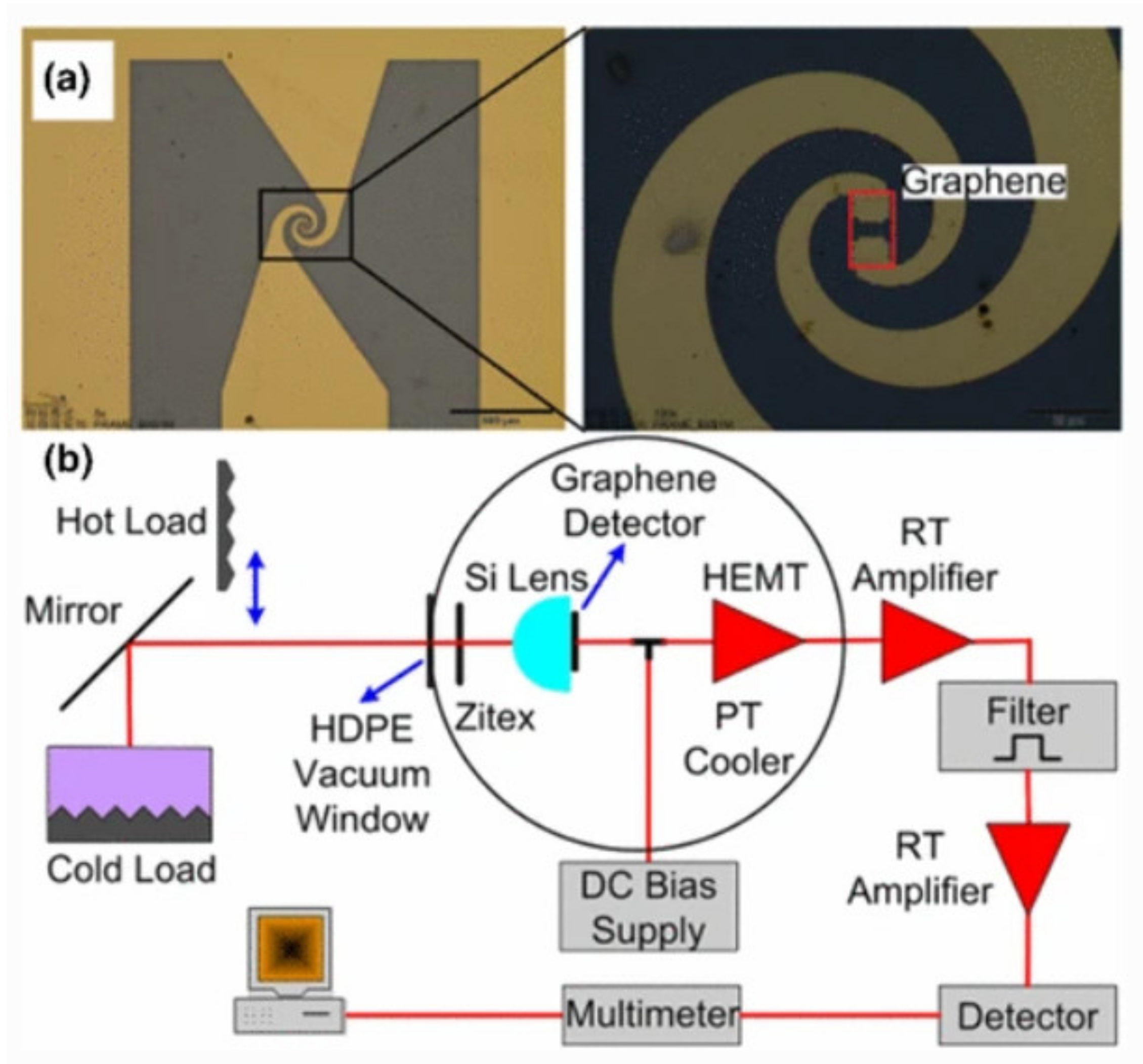
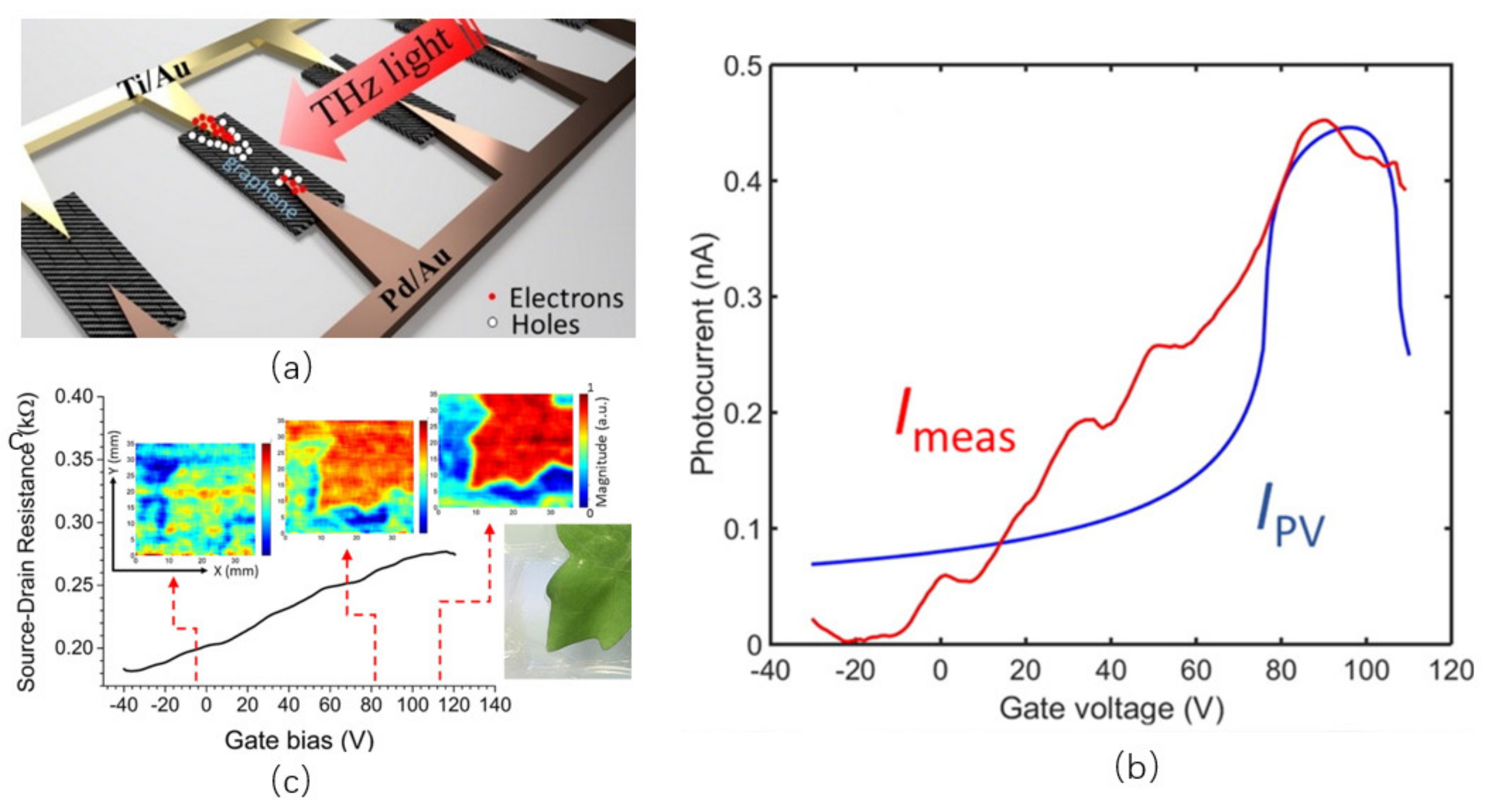
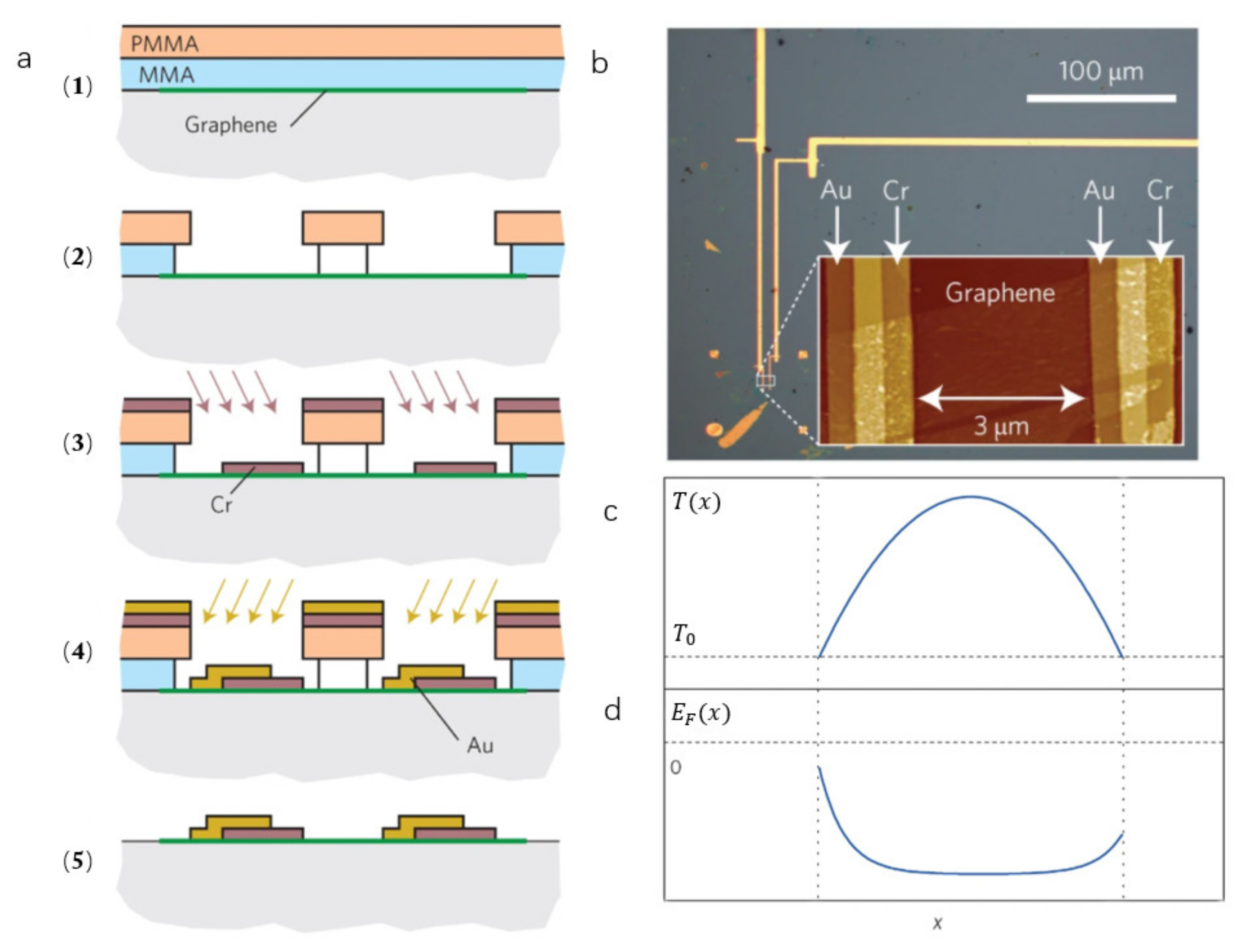
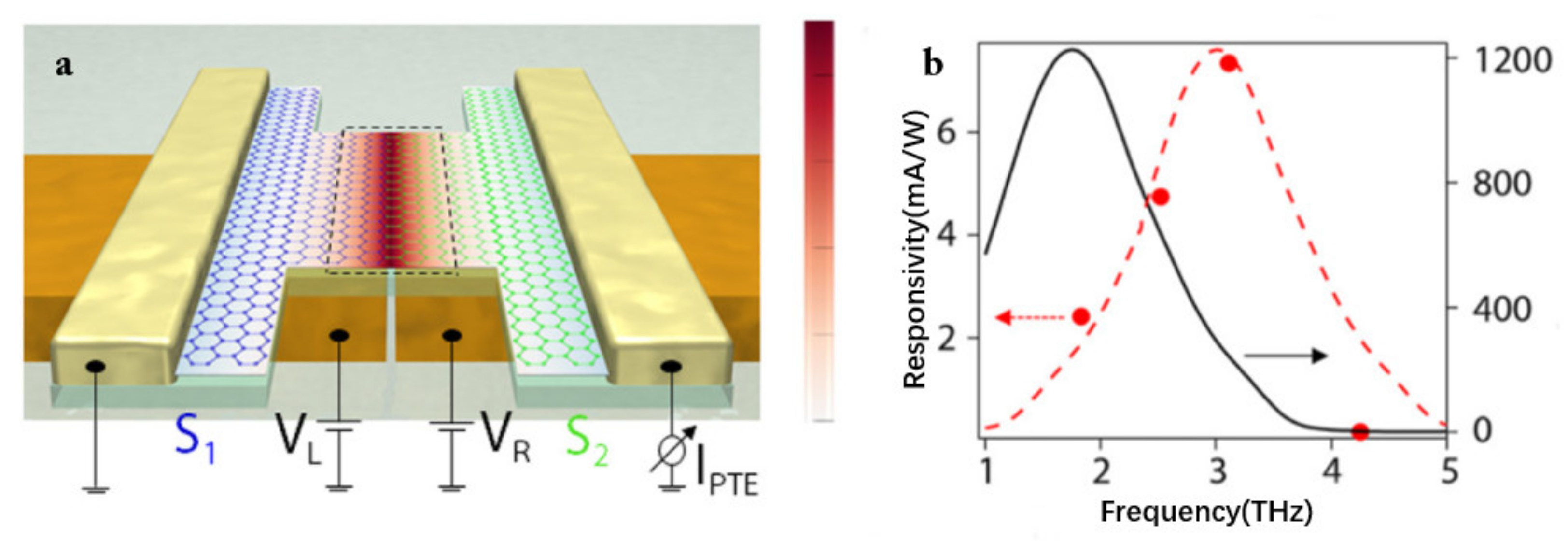
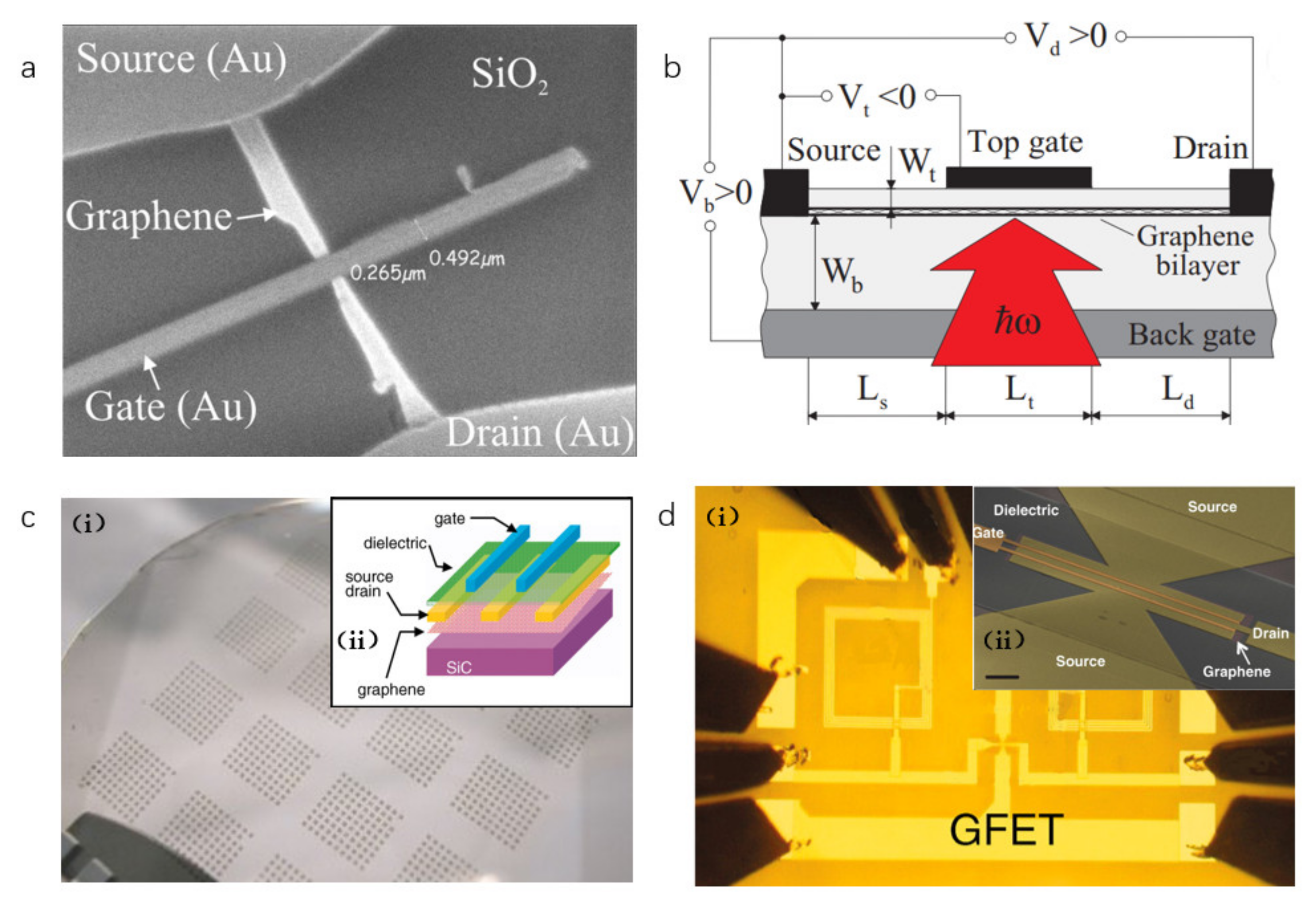

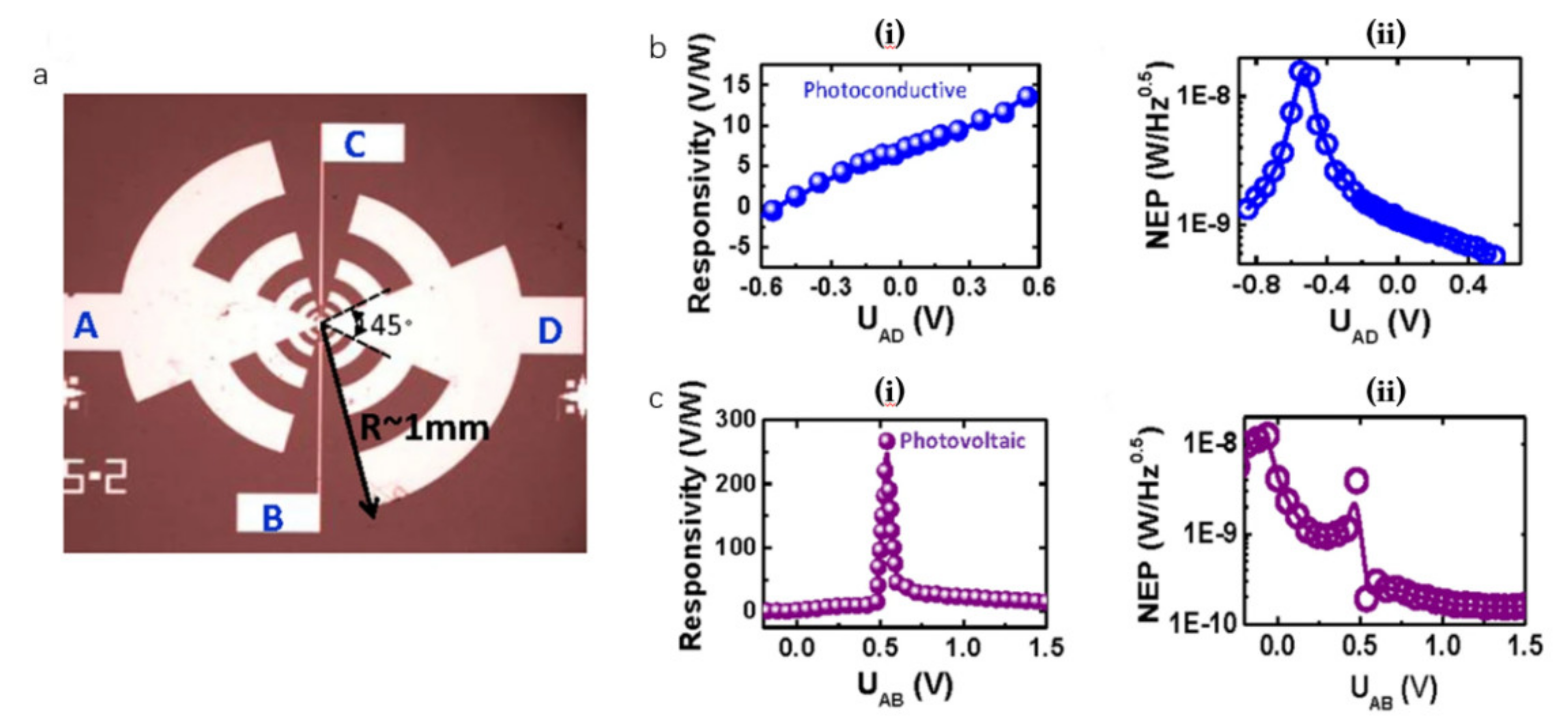



| Mechanism | Graphene Manufacturing Method | Working Frequency | Working Temperature | NEP | Responsivity | Reference |
|---|---|---|---|---|---|---|
| Bolometer | SiC epitaxial growth | 0.3–1.6 THz | 3 K | - | [66] | |
| SiC epitaxial growth | 0.7–4 THz | 2.5 K | [107] | |||
| PV | CVD | 2 THz | RT | [73] | ||
| PTE | mechanical exfoliation | 1 THz | RT | [74] | ||
| CVD | 0.11–0.3 THz | RT | [75] | |||
| mechanical exfoliation | 1.8~4.2 THz | RT | [72] | |||
| Plasma wave resonance | mechanical exfoliation | 0.3 THz | RT | [122] | ||
| SiC epitaxial growth | 0.3–0.35 THz | RT | [139] | |||
| SiC epitaxial growth | 0.2–0.65 THz | RT | [101] | |||
| mechanical exfoliation | 1–3 THz | RT | [100] | |||
| CVD | 0.6 THz | RT | [134] | |||
| SiC epitaxial growth | 0.34 THz | RT | [140] | |||
| CVD | 0.35 THz | RT | [135] | |||
| - | 3 THz | 77 K | [104] | |||
| CVD | 0.1–0.3 THz | RT | [103] | |||
| mechanical exfoliation | 0.07–0.69 THz | RT | [112] | |||
| mechanical exfoliation | 0.13 THz | 10 K | [67] | |||
| mechanical exfoliation | 0.13–2 THz | 10 K | [126] |
Publisher’s Note: MDPI stays neutral with regard to jurisdictional claims in published maps and institutional affiliations. |
© 2021 by the authors. Licensee MDPI, Basel, Switzerland. This article is an open access article distributed under the terms and conditions of the Creative Commons Attribution (CC BY) license (https://creativecommons.org/licenses/by/4.0/).
Share and Cite
Liu, J.; Li, X.; Jiang, R.; Yang, K.; Zhao, J.; Khan, S.A.; He, J.; Liu, P.; Zhu, J.; Zeng, B. Recent Progress in the Development of Graphene Detector for Terahertz Detection. Sensors 2021, 21, 4987. https://doi.org/10.3390/s21154987
Liu J, Li X, Jiang R, Yang K, Zhao J, Khan SA, He J, Liu P, Zhu J, Zeng B. Recent Progress in the Development of Graphene Detector for Terahertz Detection. Sensors. 2021; 21(15):4987. https://doi.org/10.3390/s21154987
Chicago/Turabian StyleLiu, Jianlong, Xin Li, Ruirui Jiang, Kaiqiang Yang, Jing Zhao, Sayed Ali Khan, Jiancheng He, Peizhong Liu, Jinfeng Zhu, and Baoqing Zeng. 2021. "Recent Progress in the Development of Graphene Detector for Terahertz Detection" Sensors 21, no. 15: 4987. https://doi.org/10.3390/s21154987
APA StyleLiu, J., Li, X., Jiang, R., Yang, K., Zhao, J., Khan, S. A., He, J., Liu, P., Zhu, J., & Zeng, B. (2021). Recent Progress in the Development of Graphene Detector for Terahertz Detection. Sensors, 21(15), 4987. https://doi.org/10.3390/s21154987







